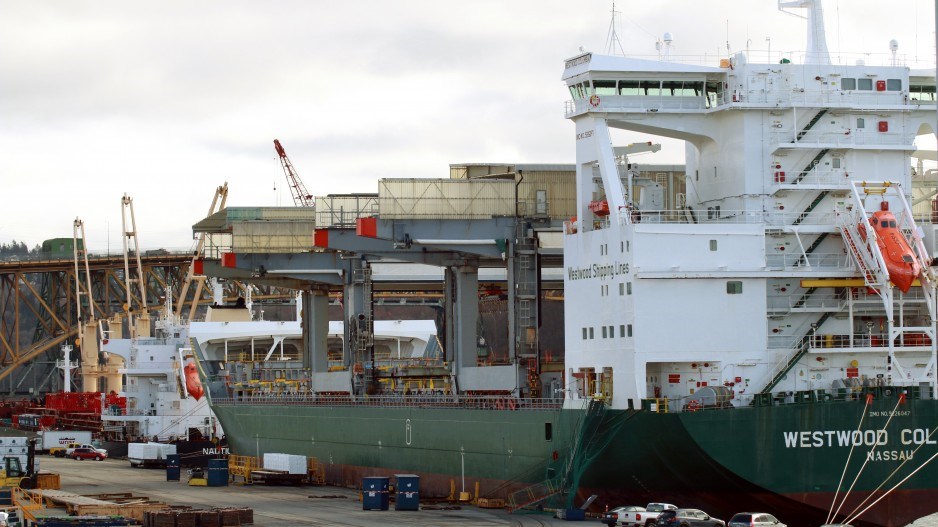Uneven Port of Vancouver cargo numbers for 2016 released today reflect a flat-lining global economy ahead and a tumultuous year past for major container carriers and other shipping lines.
Volume overall was down 1.8% to 136 million tonnes compared with 2015.
But Robin Silvester, president and chief executive officer of the Vancouver Fraser Port Authority, pointed out that, despite global economic downturns, the port’s ability to handle a wide range of cargo has helped it record its fourth consecutive year of cargo volumes of more than 135 million tonnes.
Grain was among the good-news stories from 2016. Exports through the port were up 1.3% from 2015, reflecting strong global demand and a bumper harvest in Canada.
But a 22% drop in breakbulk lumber and wood pulp dragged down breakbulk cargo, which overall was down 1.4%, as was bulk dry cargo (-2.9%).
Containerized cargo was a mixed bag. While exports were up 3.3% to 1.1 million 20-foot equivalent units (TEUs), overall container cargo handled through the port was down 4.1% to 2.9 million TEUs compared with 2015.
The port’s year-end 2016 numbers continued the trend set in the year’s first six months when total cargo shipped through the port dropped 5.9% to 66 million tonnes compared with the same period in 2015.
Container traffic, which has grown steadily through West Coast B.C. ports over the past five years, especially in 2015, was also down significantly [6.5%] in the year’s first six months.
The drop in container traffic, in part, reflects the cargo boom in 2015 when major deep-sea container shipping companies diverted large numbers of U.S.-bound containers to West Coast Canadian ports because of goods movement interruptions caused by protracted dock worker contract negotiations at West Coast U.S. ports.
The Port of Vancouver’s numbers also reflect a slowdown in the global economic growth, which worsened an already difficult year for global shipping lines. The companies, faced with overcapacity and record low freight rates on major cargo routes, are in a struggling industry that has lost more than US$50 billion in sales since 2014.
The outlook for 2017 is less dire than the realities of 2016.
However, the global forecast for container traffic remains far more subdued than earlier in the decade.
During a January 24 webinar on global container ports and terminals, Neil Dekker, director of container research at U.K.-based shipping consultancy Drewry, noted that the world economy is moving into a new era of “fairly low global growth.” That growth in 2015, he said, was around 1.3%.
“Our latest assessment for 2016 is about the same, so the days of 4%, 5%, 6% 7% global growth are long gone.”
Dekker said Drewry’s outlook of relatively static container shipping growth extends to 2020.
But he added that the more immediate horizon for 2017 was somewhat brighter with global growth forecast at around 2.1% and growth on the transpacific trade route of approximately 3.2% in 2016 and the same or slightly less for 2017.
Dekker said 2016, an extremely tumultuous year for container shipping, was notable in a number of ways, including the increase in vessel scrapping aimed at reducing the container shipping sector’s overcapacity. An estimated 670,000 20-foot equivalent units (TEUs) of capacity was scrapped during the year.
That, Dekker said, helped bring supply and demand in tune with the overall global level for the “first time in many years.”
Reasons for optimism in the container shipping sector outlined in the webinar included stronger demand, higher fuel prices and what Drewry described as a “more disciplined commercial approach that carriers are taking.”
But the addition of 82 new and larger container ships to major container fleets in 2017-18 will largely offset that capacity reduction.
This, said Dekker, will “put increased pressure on the cascade and the ability of all lines to deploy them without doing any damage to the trade lane fundamentals.”
Alphaliner noted in a January 18-24 newsletter that vessel deliveries will outpace scrapping by a 2-1 margin in 2017.
The global container shipping data company said that 78% of the 1.69 million TEUs of new capacity will be concentrated in ships of more than 10,000 TEUs.
Container carrier shipping lines collectively lost US$1 billion in 2016’s third quarter alone, and Drewry estimates the sector will finish the fiscal year with a loss of US$5 billion.
In its 2016 annual report, Denmark’s Maersk Line (CPH:MAERSK-B), the world’s biggest container shipping company, posted a US$384 million loss compared with a US$1.3 billion profit in 2015. The company blamed poor market conditions that seriously eroded container-shipping rates as a one of the main reasons for the loss.
Drewry’s outlook for a somewhat brighter 2017 is shared by the National Retail Federation (NFR). The U.S.-based organization’s latest Global Port Tracker projected a 4.6% increase in imports to U.S. major retail container ports during the first half of the year.
The NFR noted that ports covered by the tracker handled 10.2% more cargo in December 2016 compared with the same month in 2015 and 6.6% more in January 2017 than in January 2016.
Maersk Line is also more bullish on the year ahead.
Its outlook for 2017 is a profit of more than US$1billion compared with its US$384 million loss in 2016 based on a forecast of global container shipping growing between 2% and 4% in 2017.




